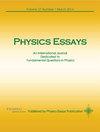经典多普勒频移解释Michelson-Morley零结果
IF 0.5
Q4 PHYSICS, MULTIDISCIPLINARY
引用次数: 0
摘要
在这里,我们回顾了Michelson-Morley对干涉仪实验的原始分析,并讨论了其对光学距离的使用。我们从几何角度推导了横向多普勒频移的公式,将其应用于迈克尔逊-莫雷干涉仪,并对实验进行了相位分析。此外,我们提出了一个在一般角度下的多普勒频移方程,并用它来推导任何任意角度下往返干涉仪路径的零相移结果。我们不质疑零结果的有效性,也不质疑干涉仪横向和纵向臂的到达时间差的预测;相反,我们挑战了到达时间差必然会导致可观察到的条纹偏移的隐含假设。本文章由计算机程序翻译,如有差异,请以英文原文为准。
Classical Doppler shift explains the Michelson‐Morley null result
Here we review Michelson‐Morley's original analysis of their interferometer experiment and discuss its use of optical distance. We derive a formula for transverse Doppler shift from geometric considerations, apply this to the Michelson‐Morley interferometer, and present
a phase analysis for the experiment. Furthermore, we present an equation for Doppler shift at a general angle and use this to derive the null phase shift result for round-trip interferometer paths at any arbitrary angle. We do not dispute the validity of the null result, nor the prediction
of an arrival-time difference for the transverse and longitudinal arms of the interferometer; rather, we challenge the implicit assumption that an arrival time difference will necessarily result in an observable fringe shift.
求助全文
通过发布文献求助,成功后即可免费获取论文全文。
去求助
来源期刊

Physics Essays
PHYSICS, MULTIDISCIPLINARY-
自引率
83.30%
发文量
50
审稿时长
6-12 weeks
期刊介绍:
Physics Essays has been established as an international journal dedicated to theoretical and experimental aspects of fundamental problems in Physics and, generally, to the advancement of basic knowledge of Physics. The Journal’s mandate is to publish rigorous and methodological examinations of past, current, and advanced concepts, methods and results in physics research. Physics Essays dedicates itself to the publication of stimulating exploratory, and original papers in a variety of physics disciplines, such as spectroscopy, quantum mechanics, particle physics, electromagnetic theory, astrophysics, space physics, mathematical methods in physics, plasma physics, philosophical aspects of physics, chemical physics, and relativity.
 求助内容:
求助内容: 应助结果提醒方式:
应助结果提醒方式:


